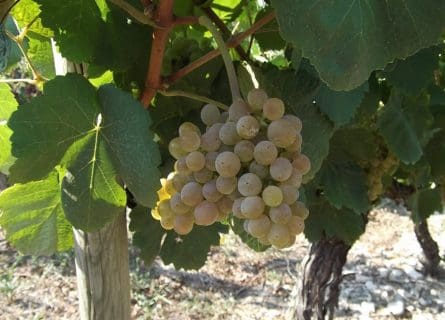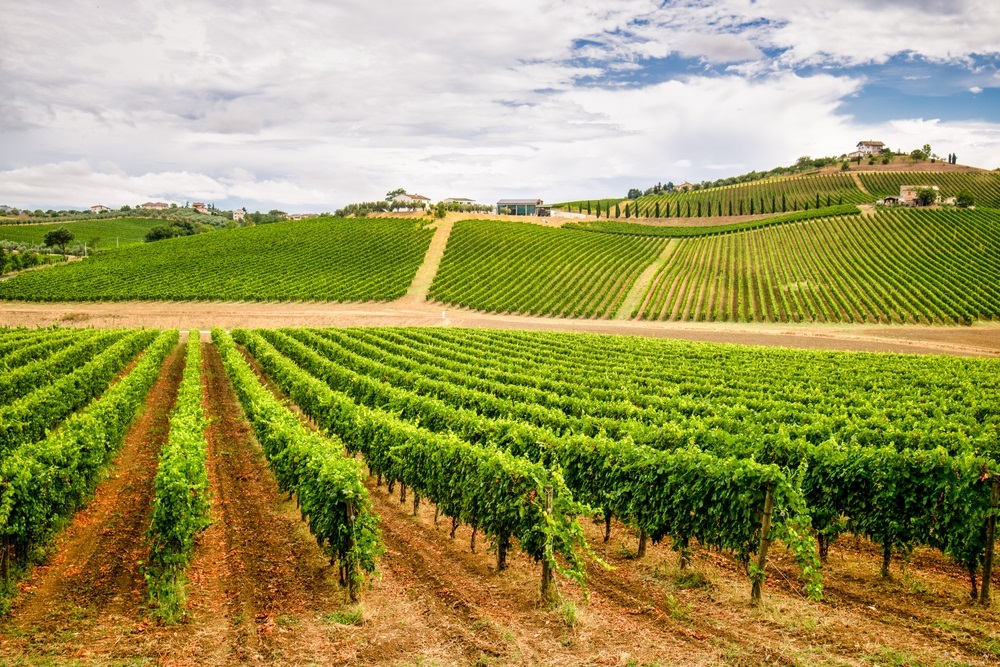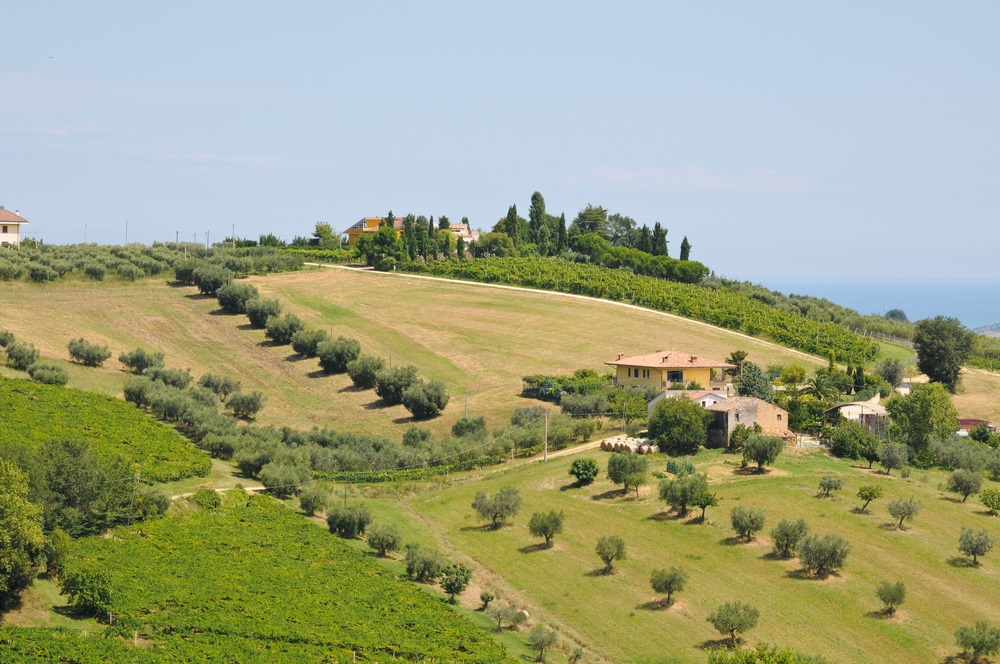
Bourboulenc Grape Variety
August 15, 2022
Bourboulenc is a white wine grape variety grown mainly in Southern Rhône, Provence, and Languedoc in southern France.
By: James lawrence / Last updated: February 5, 2025
Estimated reading time: 1 minute
Montepulciano grape is an outlier among Italy’s eclectic palette of red grape varieties. It lacks the international renown of Sangiovese (although it is Italy’s second most widely planted indigenous variety) and the glamour of Nebbiolo. It is not achingly trendy; it does not lend its name to luxury brands marketed at oligarchs. And yet, you’ll find Montepulciano across central and southern Italy, in provinces as diverse as Lazio, Marche, and Molise. There are over 45 appellations that allow the grape in the blends, albeit few insist on 100% Montepulciano wines. This misunderstood red grape is a complex and contradictory animal like the Italians.

Guide to Italian Red Wine: Read more
Historically, there has been a tendency to damn Montepulciano with faint praise. The grape has never faced widespread ridicule, but people have also not traditionally seen Montepulciano as a ‘noble’ variety. People most commonly describe Montepulciano as ‘soft’ and ‘easy-drinking,’ and winemakers craft many versions for enjoyment at a young age. However, it is often a pleasant, innocuous, and relatively unexciting red wine.
However, an emerging generation of Italian winemakers are starting to achieve great things with Italy’s unsung hero. If winemakers plant the grape on good terroir and handle it with care in the winery, a more refined and age-worthy product can emerge. Instead of “easy drinking,” you’ll encounter an intense and powerful wine with enough structure and extract to age for several years after bottling. There is more than a whiff of Merlot about premium-grade Montepulciano, with its accessible tannins and beguiling fruit profile of plum jam, red berries, and eucalyptus. And like Merlot, it can produce excellent wine as a standalone varietal or as part of a blend.
The exact origins of the grape are a mystery. Curiously enough, although the variety shares its name with a town in Tuscany, the Montepulciano grape is not permitted under the Vino Nobile di Montepulciano DOCG framework rules. Genetic analysis has shown that Montepulciano is a close relative of Sangiovese; however, it does not play a defining role in the contemporary viticulture of central Tuscany. Yet, there are many zones in central Italy where Montepulciano is a ubiquitous feature of the landscape, particularly in the Adriatic coastline and Umbria. The dark-skinned Montepulciano grape thrives in the heart and soul of central Italy, its timeless countryside epitomized by rolling foothills, olive groves, and endless vines.
Nevertheless, elevation, soil, and aspect vary enormously in this part of Italy. Consequently, it isn’t easy to generalize Montepulciano’s inherent stylistic qualities beyond the classic flavors of the grape. Poor examples are thin, tart mouthwash with little charm or structure – the best wines are rich gastronomic superstars. The two most common soil types are galestro and Albanese – galestro describes crumbly clay-limestone, while Albanese refers to colder and heavier soils with higher clay content. Both terroirs are ideally suited to cultivating the Montepulciano grape, which tends to produce richer and heavier wines.
But the real trick to ripening the grape successfully is sunshine and plenty of it. As a late-ripening variety, Montepulciano needs a long, warm growing season to achieve satisfactory phenolic maturity. The most significant viticultural hazard is its tendency to produce overly generous yields; when the skin-to-juice ratio is unbalanced due to inflated bunches, Montepulciano can make very dilute and lackluster wine. Therefore, poor soils and a judicious pruning regime are essential if the grower intends to make a premium label. Nevertheless, Montepulciano does not cause endless headaches – unlike Pinot Noir – during the vintage season and has a strong natural resistance to fungal diseases like powdery mildew. Moreover, unlike Sangiovese, Montepulciano has moderate levels of accessible tannin that rarely veer into astringent territory.
At this point, you may well ask: who is making the best Montepulciano today? That is very much a matter of opinion; however, many would regard the wines of Montepulciano d’Abruzzo as one of the leading contenders. Awarded DOC (Denominazione di Origine Controllata) status in 1968, the appellation encompasses a large expanse across the Abruzzo region of southern Italy. Cultivated since the 1700s, Montepulciano has responded well to the zone’s hot Mediterranean climate and calcareous soils, producing concentrated and structured wines that are nonetheless approachable upon release.
Such a large zone inevitably contains a great diversity of vineyard sites, but most winegrowers regard the coastal vineyards as being in the first division. Benefiting from the cooling breezes of the Adriatic, the most coveted vineyards are planted on higher altitude plots that also benefit from cooler temperatures and concomitantly higher acidity levels and freshness. Five viticultural sub-zones in the wider appellation vary in soil structure, elevation, and proximity to the sea. Of the five, Alto Tirino and Casauria are particularly well regarded; Teate, Terre dei Peligni, and Terre dei Vestini constitute the final three.
Local attitudes to winemaking are no less diverse. Under the DOC framework, growers can either release a 100% Montepulciano wine or blend in up to 15% Sangiovese. The latter philosophy tends to create wines with more acidity and tannin in their youth, and consequently, they are arguably slightly less approachable than ‘pure’ Montepulciano styles. Nevertheless, they can age well after a few years and evolve into glorious velvety complexity. Oak aging is a subject that always divides opinion; light, fresh versions such as Cerasuolo A’bruzzo make the ideal summer aperitif, but a dash of barrique can add weight and structure to ripe Montepulciano. In addition, the appellation rules market a higher Riserva tier – Montepulciano d’Abruzzo Riserva, which must spend at least six months in oak and be three years old at the time of commercialization.
Equally, great wine comes from the vineyard rather than the cellar. Critics unanimously agree that the finest terroir lies in the hills around the town of Teramo, which received its own DOCG status in 2013. A potent marriage of good proximity to the Adriatic, meager soils, and mandatory low yields creates something exceptional in the bottle. If used at all, winemakers can only add up to 10% Sangiovese to the blends. All wines marketed under the Montepulciano d’Abruzzo Colline Teramane DOCG must undergo aging for two years, with at least one year in a barrel. Riservas, meanwhile, will have spent three years (a combination of barrel and bottle) aging before release.

Tasted blind, the top example of Teramane, is a dead ringer for Tuscan Merlot from Bolgheri. Young wines typically offer a seductive palate of red and black fruits, with pronounced aromas of sour cherry, rosemary, plum, and damson. Tobacco flavors, tar, chocolate, and oregano should emerge with age. There is an exotic quality to the best Montepulciano from this zone, with a tannic structure and extra layer of refinement lacking in the simpler bottlings from inferior terroirs.
Of course, winegrowers in the neighboring region of Marche have their own ideas about the ‘best’ Montepulciano wines. The reds of the area have been slow to gain much global recognition – the upside is that expensive labels are almost unheard of in Marche. Nevertheless, you can discover a world of value in the Rosso Conero and Rosso Piceno zones. The former gained DOC status in 1967. Montepulciano must comprise at least 85 percent of the blend in Rosso Conero, with Sangiovese filling the remainder.
The vineyards flank the slopes of Mount Conero, southwest of the city of Ancona, between the Adriatic Sea and the Apennines. Mineral-rich calcareous soils suit the variety down to the ground, as does the continental climate and hot summer season. The resulting wines tend to have more tannic ‘grip’ than Montepulciano d’Abruzzo and can benefit from 1-2 years of bottle age after release.
The wines of Rosso Piceno are no less excellent. The terroir includes the provinces of Ancona and Macerata, with a great diversity in altitude. Some growers seek out sites as high as 600 meters above sea level due to the favorable diurnal temperature variation and enhanced freshness, a quality often prioritized by winemakers. Others, however, prefer the low slopes and the alcoholic might that flows from the hot Mediterranean climate – rainfall is very scarce between June and September. Heavy clay soils dominate, as elsewhere.
Culturally, winegrowers in the Rosso Piceno DOC zone tend to walk a different path. Common practice, and indeed allowed under the appellation rules, involves adding up to 50% Sangiovese to the final blend. Wines aged in barrel for at least one year earn the ‘Superiore’ designation. However, local winemakers have never pushed to make 100% Montepulciano varietal wines, arguing that Sangiovese is necessary to add structure and ‘heft’ to the final product. But regardless of whether we agree with them, the output quality is generally very high. The wines tend to be soft and approachable in their youth due to the high levels of phenolic ripeness that are easy to achieve. Occasionally, they have port-like qualities and are too jammy, but top wines balance freshness with intense concentration. Chocolate, plum, blackberry, and mocha are classic aromas in young wines, tobacco and cloves in older vintages.
This brings us nicely to the dinner table. Montepulciano, blended or produced as a standalone wine, can tackle various dishes. In Abruzzo, they will likely serve you Montepulciano with lamb all’ Abruzzese, a dish featuring a slow-roasted leg of tender lamb roasted and basted in a delicious concoction of tomatoes, herbs, and wine. In Marche, local restaurants will seldom not create their version of a fillet of pork (Lonza) cooked with fennel. At the same time, salt-cured mountain ham, or Prosciutto di Carpegna DOP, is a ubiquitous staple of the province. Stuffed rabbit and pigeon are also commonly enjoyed – all enticing dishes that will love the softness and gentle acidity of premium-grade Montepulciano. Hard cheeses, tomato-based pasta sauces, and cured meats are all tried and tested pairings that make both the food and wine sing.
Indeed, Montepulciano is very much a wine crafted to deliver endless pleasure to all. Unfortunately, many growers and brand owners, particularly in Burgundy, are now pricing their wines at levels only the obscenely wealthy can afford. How glorious, then, to celebrate a democratized wine style that is readily available and made by generations of the same family. The grape may not offer connotations of luxury, but it is undeniably authentic and keenly priced. In an increasingly globalized and homogenized world, Montepulciano is the real deal.
If you would like us to customize an exclusive luxury tour, contact us and let us know your travel plans. We offer luxury food and wine tours for private groups of a minimum two guests. In addition, all of our private, chauffeured tours are available year-round upon request.

